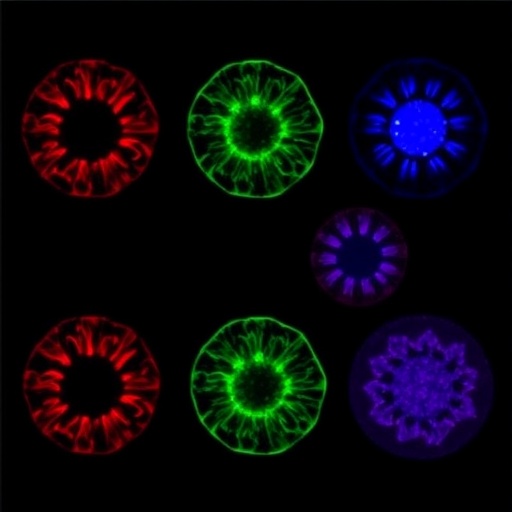In a groundbreaking advancement poised to revolutionize our understanding of women’s reproductive health, a team of researchers has employed cutting-edge single-cell and spatial omics technologies to unravel the complex molecular landscape underlying ovarian endometriomas. This multifaceted investigation, recently published in Nature Communications, sheds light on the intricate transcriptional and metabolic networks that drive the development and progression of these enigmatic cystic lesions, which have long perplexed clinicians and scientists alike due to their heterogeneous nature and elusive pathophysiology.
At the heart of this pioneering study lies the utilization of single-cell transcriptomics, a powerful tool that allows researchers to dissect the gene expression profiles of individual cells within the ovarian endometriomas. By isolating and analyzing thousands of cells at unprecedented resolution, the investigators were able to characterize the cellular heterogeneity within these lesions, identifying distinct cellular subpopulations contributing to disease pathology. This granular perspective provides critical insights into how specific cell types interact within the complex microenvironment of the ovary, enabling a refined understanding of disease mechanisms that had previously remained obscured.
Complementing the transcriptional data, the team integrated spatially resolved omics techniques to map the distribution of metabolic activities directly within the tissue architecture of ovarian endometriomas. This spatial dimension is a major leap forward, as it contextualizes molecular information within the physical landscape of the lesion, revealing how metabolic rewiring accompanies and possibly fuels disease progression. Importantly, these spatial maps highlighted distinct metabolic niches, underlining the metabolic heterogeneity that correlates with various cellular states and local microenvironmental cues.
One of the most compelling revelations from this study is the identification of unique transcriptional signatures that define the abnormal cellular phenotypes characteristic of ovarian endometriomas. These signatures include the upregulation of genes involved in inflammation, extracellular matrix remodeling, and angiogenesis, which collectively orchestrate the aggressive behavior of the lesions. Such a molecular blueprint underscores the dynamic interplay between immune responses and stromal compartment remodeling, painting a detailed portrait of the pathological landscape that sustains and exacerbates the disease.
Moreover, the metabolomic component of the investigation uncovered profound alterations in energy metabolism pathways within the affected ovarian tissue. The lesions exhibited a pronounced shift toward glycolytic metabolism, reminiscent of the Warburg effect observed in malignant tumors, despite ovarian endometriomas being benign. This metabolic reprogramming may serve as both a driver and consequence of the chronic inflammatory milieu, fostering an environment conducive to lesion persistence and resistance to conventional therapies.
The integration of single-cell and spatial omics data not only illuminates the molecular underpinnings of ovarian endometriomas but also opens avenues for the identification of potential biomarkers for diagnosis and therapeutic targets. By spotlighting specific metabolic enzymes and regulatory molecules dysregulated within discrete cellular subsets, the study lays the groundwork for precision medicine approaches tailored to the unique molecular fingerprints of individual lesions.
Importantly, this research addresses a critical gap in the study of endometriosis, a condition affecting millions worldwide yet marked by diagnostic challenges and limited treatment options. The complexity and variability of ovarian endometriomas have historically hindered effective clinical management. This comprehensive molecular atlas may thus catalyze a paradigm shift, enabling earlier detection, stratification of patients based on molecular features, and the development of targeted interventions that disrupt key pathological pathways.
Beyond the direct clinical implications, the methodology exemplified here represents a versatile blueprint applicable to a wide range of diseases characterized by tissue heterogeneity and metabolic dysregulation. The combination of single-cell transcriptomics with spatial metabolic profiling establishes a robust platform for unraveling the cellular composition and functional states within complex tissue environments, offering unprecedented resolution and contextual insight.
From a technical standpoint, the team harnessed advanced bioinformatics pipelines to integrate multi-omics datasets, tackling challenges associated with data dimensionality, batch effects, and spatial registration. Sophisticated clustering algorithms and network analysis tools facilitated the extraction of biologically meaningful patterns, while spatial mapping was enabled through innovative imaging mass spectrometry techniques that quantified metabolites with high spatial fidelity.
The implications of this work extend to the broader field of gynecologic pathology, where similar spatial and transcriptional complexities govern disease behavior. By delineating the cellular and metabolic topography of ovarian endometriomas, the study contributes to a deeper understanding of the interplay between cellular identity, metabolic state, and tissue architecture—a nexus fundamental to disease phenotypes.
Furthermore, the findings spotlight the role of microenvironmental factors in shaping metabolic adaptations. Hypoxia, immune cell infiltration, and stromal interactions likely converge to drive the observed metabolic rewiring and transcriptional shifts, suggesting that therapeutic strategies should consider not only the aberrant cells but also their surrounding niche.
The rich dataset generated also provides a valuable resource for the research community, enabling hypothesis generation and validation in other contexts of ovarian pathology. Future studies will undoubtedly build upon this foundation, exploring longitudinal changes, treatment responses, and the link between molecular signatures and clinical outcomes.
In summary, this seminal study harnesses the synergy of single-cell and spatial omics to deliver unprecedented insights into the molecular and metabolic intricacies of ovarian endometriomas. It paves the way for innovative diagnostic and therapeutic strategies that promise to improve the lives of countless women afflicted by this challenging condition. As omics technologies continue to mature, their integration will be critical in dissecting the cellular ecosystems underpinning complex diseases and translating fundamental discoveries into clinical breakthroughs.
Subject of Research:
Single-cell and spatially resolved omics analysis of ovarian endometriomas revealing underlying transcriptional and metabolic alterations.
Article Title:
Single-cell and spatially resolved omics reveal transcriptional and metabolic signatures of ovarian endometriomas.
Article References:
Qi, Y., Chen, X., Zheng, S. et al. Single-cell and spatially resolved omics reveal transcriptional and metabolic signatures of ovarian endometriomas. Nat Commun (2025). https://doi.org/10.1038/s41467-025-66706-8
Image Credits: AI Generated




